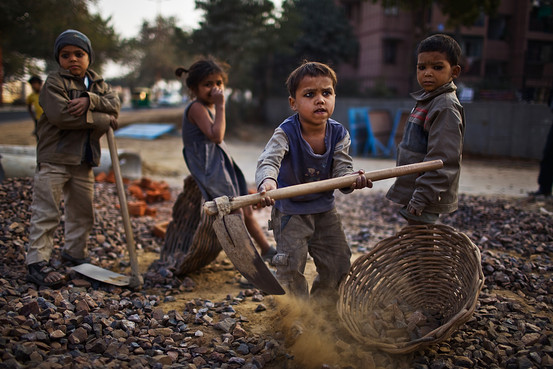Child Labour Laws: From Abolition to Legalisation
Child Labour In India

HYDERABAD: The Child Labour (Prohibition and Regulation) Bill, 2012 envisages a perceptible change in the enforcement and regulation of illegal employment of minors in productive labour activities. The amendment proposed to the current law which was enacted in 1986 includes changes in the protective ambit of the legislation and deterrent-oriented punishment for violators. The bill proposes a ban on employment of children aged under 14 years in all kinds of commercial enterprises with some exceptions, which the Cabinet claims have been made keeping in mind the ‘social fabric’ of the country. The proposed amendment to the Child Labour act also brings out a new category of ‘adolescents’, children between the ages of 14 and 18 who are prohibited from being employed in any harmful process or industry. Yet, the exceptions provided for within the 14 year bracket and the minimisation of ‘hazardous’ industries betray a weakening of labour laws, a resoundingly problematic feature in the light of the powerful Make in India lobby.
The Statement of Objects and Reasons of the bill states that bringing in this change would make the Indian law in line with the Conventions of the International Labour Organisation, Convention 138 and 182 on child labour. Despite the amendment’s appearance at taking a stricter stance towards underage labour exploitation, the exceptions provided for under the Bill in effect, broaden the scope for misuse and evasion from implementation. Regardless of the ownership of the business in which the child is employed, the fact of exploitation is not done away with. Allowing for the exceptions based on ‘family’ enterprise related work brings up complex questions of the definition of ‘family’ work and the difficulty in checking the compliance of the limitation rises exponentially. Such a widely worded exception provides a back door for defeating the legislation’s object, particularly when a majority percentage of all child labour in the country happens under a parent or relative’s subordination. This was pointed out by the Parliamentary Standing Committee on Labour 2013-14 in its 40th report on the Child Labour (Prohibition and Regulation) Bill, 2012, which categorically provided that the exception itself incorporated a loophole as it would be very difficult to ascertain whether a child was merely helping her parent or working to supplement the income of his family.
The Act places the major brunt of the so-called ‘social fabric’ burden on women and children. Women and girls contribute largely to household work in subsistence families, and the Act legitimises child labour to the extent that it allows after school labour as well as all agricultural and home-based work. A domestic work exception thus, could instigate a fall in school enrolment rates and female literacy, and goes against the mandate of the right to education act which undertakes compulsory schooling. The act also has possible repercussions on the equal treatment of boys and girls. It projects a structural bias against girl children in domestic work situations.
The most obvious and onerous concern regarding the passing of this amendment is the impact it would have on social mobility prospects of the professionally marginalised poor. The bill regurgitates and repackages the idea of caste baste lineage in the name of vocational training that children will derive by ‘learning’ from their parents at a young age. The idea that it is alright for a child to contribute to productive labour of his family’s trade and develop his skills in that trade presupposes the notion of inevitability in the child’s eventual social position. The child of an artisan will be an artisan, the child of a beedi-roller a beedi-roller and children will continue to do agricultural labour. The act’s inclusion of these exceptions on the grounds of socio-economic conditions in India marks a clear abnegation on the part of the government in engaging with the conditions of poverty that compel children to be employed as cheap sources of labour in the first place. Moreover, the bill’s decriminalisation of eighty-three ‘hazardous’ activities to a paltry three as per the Factories Act,1948, pushes a larger section of child labour into the informal sector and away from the ambit of the legislation. A total of 5,254 children rescued by Bachpan Bachao Andolan run by Nobel laureate Kailash Satyarthi in the last five years had been working in 30 occupations that the amended Bill proposes to remove from the hazardous list. Many hazardous industries come under family enterprises including carpet-weaving, glass works and sports goods manufacturing, which would be protected from corrective action if the amendment were to pass muster.
It is evident that the bill suffers from multiple lacunae in its substantives and the possibilities of its effective implementation. Neither does it follow the letter and spirit of the International Labour Conventions which seek the abolishment of worst forms of labour. Ultimately, justice delivery and executive accountability are needed for India to conform to the ideals espoused in the UNCRC 1989 on the right of every child to study, play and dream.
(The writer is a student at the NALSAR University of Law).


